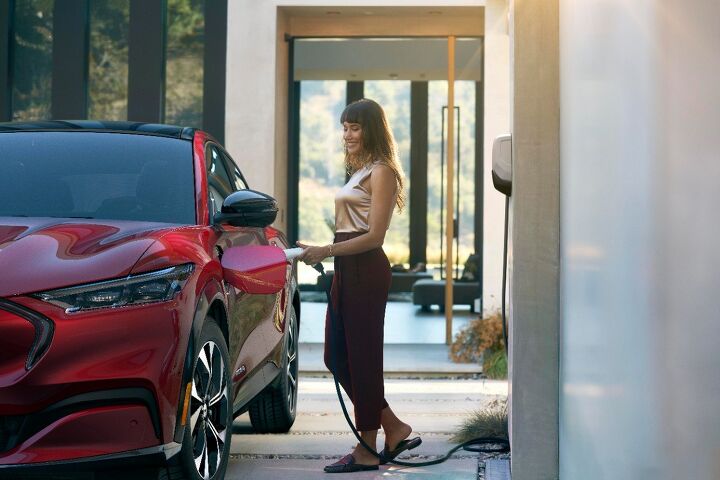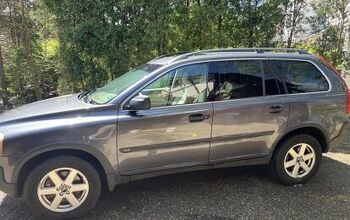BMW, Ford, Honda to Form New EV Charging Company

Ford, Honda, and BMW have announced plans to create a new “vehicle-to-grid company” that’s aimed at standardizing vehicle charging via a singular platform. The service also seeks to return excess energy to the electrical grid, effectively converting EVs into publicly shared batteries.
The business will be known as ChargeScape and, according to the automakers' press release, seeks to “create a single platform that will seamlessly connect electric utilities, automakers and their interested EV customers to manage energy usage for a broad pool of EVs.” The scheme could be one way of addressing concerns that modern power grids couldn’t endure widespread electric vehicle usage while helping to position the involved companies in an industry that’s being heavily incentivized by the government.
The company is still pending regulatory approvals, as we used to be concerned about corporate monopolies and are bound by tradition to pretend that still happens. Assuming ChargeScape is given the green light to move ahead, the trio plans to have equal shares and for the business to get rolling in 2024.
While EV charging companies owned by vehicle manufacturers are hardly new, ChargeScape is hoping to set itself apart by focusing on sharing the energy stored in their EV batteries with the electric grid — especially during periods of peak demand. Logistically, this would help soften the blow for public utilities hoping to deliver energy when demand surges throughout the day. But customers would also benefit by having the ability to sell back stored energy using a vehicle equipped with bidirectional charging capabilities which can be recouped at a lower price later on.
Though whether that theory plays out as advertised remains to be seen. Engineers have discussed the assumed need for localized energy storage as the demand for electricity grows and tapping into EVs could be a clever way of avoiding having to construct warehouse-sized battery hubs. This could likewise help circumvent some of the ecological issues associated with battery production and disposal by reducing the total number required to keep the energy grid functioning. But the premise of someone contentedly offloading battery range seems unlikely unless there’s a true financial incentive and customers feel absolutely certain there will be enough power left over for them when needed.
ChargeScape plans on addressing this by offering equipment that would help people manage energy sales during peak demand periods while also scheduling charging times during off-peak times. This could even be done by the company itself, rather than having customers set their own preferred schedules. Of course, this opens up the door to some of the unsavory aspects of smart home appliances that wrangle control away from the customer.
“Electric grid reliability and sustainability are the foundation for an EV powered future,” said Thomas Ruemenapp, Vice President, Engineering, BMW of North America. “ChargeScape aims to accelerate the expansion of smart charging and vehicle-to-everything solutions all over the country, while increasing customer benefits, supporting the stability of the grid and helping to maximize renewable energy usage. We’re proud to be a founding member of ChargeScape and are looking forward to the opportunities this collaboration will create.”
The companies are hoping to sell the concept as a way to help “decarbonize” the energy grid. ChargeScape will allegedly help “reduce EV customers’ personal carbon footprints” by utilizing electricity stemming from renewables like wind and solar. However, it’s not clear how that would work in parts of the country that are heavily reliant on other forms of energy production.
“Electric vehicles are unlocking entirely new benefits for customers that can save them money while supporting grid resiliency and increase the use of clean, renewable energy,” stated Bill Crider, global head of charging and energy services for the Ford Motor Company. “ChargeScape will help accelerate the true potential of the EV revolution by providing significant benefits to both utilities and EV customers through smart vehicle-to-grid services.”
You’ll notice a preponderance of buzz terms that have become commonplace within the automotive sector over the last decade. But the public seems more skeptical than ever these days, with some individuals now shying away whenever a business starts discussing smart devices, sustainability, stakeholders, and claims about de-carbonization.
“As Honda seeks to achieve our global goal of carbon neutrality, we are counting on this platform to create new value for our customers by connecting EVs to electric utilities, strengthening grid resources and reducing CO2 emissions,” suggested Jay Joseph, vice president of Sustainability and Business Development, American Honda Motor Co. “With automakers accelerating toward the electrified future, we must find solutions like ChargeScape that enable all stakeholders to work together for the good of our customers, society and our industry by enabling greater use of renewable energy for and from mobility.”
It’s your author’s assumption that the above companies have seen how well-positioned Tesla has managed to become by way of having its proprietary Supercharger network and want a piece of the pie. Nearly a dozen brands have already agreed to adopt Tesla’s charging standards and the company has since begun opening its network to vehicles not wearing its emblem.
Ford, Honda, and BMW anticipate leveraging the telematics procured by selling vehicles that tabulate and transmit massive amounts of information back to their data centers. While that should help ChargeScape function without Wi-Fi-connected charging stations, it could represent a rather massive conflict of interest.
Imagine if automakers also owned gas stations and enjoyed a steady stream of information about everything your vehicle was doing at all times, including exactly when, where, and how you were refueling. That’s effectively the direction this is all heading, just with fueling stations being replaced by EV charging points (including the one you’ve installed in your home). It seems like the above could qualify for antitrust enforcement. But your author is not qualified to provide legal advice and we seem to live in an era where corporate monopolies are relatively commonplace.
Whatever the future holds, the involved companies have expressed their desire to see the other automakers “join in and fully unlock opportunities provided by ChargeScape’s grid service offerings once the company is fully operational.”
[Image: Ford Motor Co.]
Become a TTAC insider. Get the latest news, features, TTAC takes, and everything else that gets to the truth about cars first by subscribing to our newsletter.

A staunch consumer advocate tracking industry trends and regulation. Before joining TTAC, Matt spent a decade working for marketing and research firms based in NYC. Clients included several of the world’s largest automakers, global tire brands, and aftermarket part suppliers. Dissatisfied with the corporate world and resentful of having to wear suits everyday, he pivoted to writing about cars. Since then, that man has become an ardent supporter of the right-to-repair movement, been interviewed on the auto industry by national radio broadcasts, driven more rental cars than anyone ever should, participated in amateur rallying events, and received the requisite minimum training as sanctioned by the SCCA. Handy with a wrench, Matt grew up surrounded by Detroit auto workers and managed to get a pizza delivery job before he was legally eligible. He later found himself driving box trucks through Manhattan, guaranteeing future sympathy for actual truckers. He continues to conduct research pertaining to the automotive sector as an independent contractor and has since moved back to his native Michigan, closer to where the cars are born. A contrarian, Matt claims to prefer understeer — stating that front and all-wheel drive vehicles cater best to his driving style.
More by Matt Posky
Latest Car Reviews
Read moreLatest Product Reviews
Read moreRecent Comments
- Michael S6 Interesting how Toyota is filling every niche. My wife recently test drove a RX350h and this Crown Signia will probably save $5-10 thousand and offer a similar package. Toyota must be making a killing as our local Toyota dealers have hardly any stock.
- Nrd515 GM: If you are going to revive the Camaro again, PLEASE do the following:[list=1][*]Make it actually good looking, and avoid the first gen "tribute" disaster of the last 14 years. You managed to take the pretty ugly 2010 to 2106 cars and then make them even uglier for the last years. And you wondered why it didn't sell? Look at the back of the car and you really think that's a good look?[/*][*]Make the car's trunk actually useful for more than golf clubs. [/*][*]Make it slightly larger inside, the last two gens have been almost like being in a small cave. The interior was hideous, too. Boring is fine, as long as it's in black.[/*][/list=1]I am a 2 time Camaro owner ('79 and '86), and a one time Trans Am ('79) owner. Instead of a Camaro, I have owned 2 Challengers.
- Nrd515 When my '18 Torred Challenger was stolen back in Feb, I never expected to get it back in any kind of decent shape and had negotiated a deal to buy a '23 Scat Pack in Plum Crazy Purple. I almost bought my '18 in that color, but I worried I would get tired of it. I see a PCP Challenger all the time and like it, and the PCP car was equipped exactly as my present car is, so it was an easy choice. My car was found minutes after I had finished the negotiation, and 2 months later, about $2000 out of pocket, and the insurance paying about $12K in repairs, the car is back and is now a huge hassle to steal with a wheel lock, neutral release blocking plate, Carlock, and a Fast 5.0 throttle lock out. No cell phone with the correct code, all it does is idle.
- Nrd515 I have an '18 Challenger too, use my trunk daily, and just like my '10 Challenger, and my '08 Charger, the factory struts soon weakened to the point I got conked on the head when it was under 50 degrees outside. You can't hold the trunk open and pick up a heavy or awkwardly shaped object, so getting nailed was a constant threat. I bought new factory struts for the two older cars, and within a year was getting conked or coming close to getting conked. I finally bought a set of enhanced power struts and I wish I had done it back about 2010 when my Charger "got me" the first time. I've had them for over 19 months and they still are stronger then the factory ones. Once the lid is up, it stays up, even at about 0 degrees F.
- BobinPgh Bozi I have seen pit stops and it seems you have to be more of an athlete than a mechanic. So I am surprised that you got into from writing. Did you play a sport in school? Do you work out at the gym? Are you starting to get "too old" for this? Just going over the wall you have to be a young man. Do you have to stay away from the sweets and the fat?


































Comments
Join the conversation
having five diffetent suprcharger networks is TERRIBLE Business, and shows that people are HISTORICALLY ILLITERATE.
IF they KNEW the History of the US in the 19th century, they would know how DISASTROUS was the competition between rival railroads ALL of which would develop rails between A and B instead of JUST ONE DAMNED LINE for ALL of them.
Legendary Financier JP Morgan saved those morons from utter destruction by consolidating the industry and eliminating that DISASTROUS competition that produced HUGE REDUNDANCY and terrible losses to the idiots who did it.
I'm more interested in the brunette charging the fake Mustang.